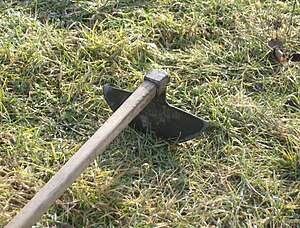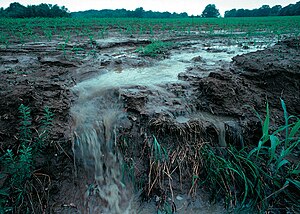 Image via WikipediaThe purposes of cultivation are three-fold: To get rid of weeds, and to stimulate growth by (1) letting air into the soil and freeing unavailable plant food, and by (2) conserving moisture.
Image via WikipediaThe purposes of cultivation are three-fold: To get rid of weeds, and to stimulate growth by (1) letting air into the soil and freeing unavailable plant food, and by (2) conserving moisture.1. Weeds:
As for weeds, the gardener of any experience need not be told the importance of keeping his crops clean. He has learned from bitter and costly experience the price of letting them get established. He knows that one or two days' growth, after they are well up, followed perhaps by a day or so of rain, may easily double or treble the work of cleaning a patch of onions or carrots, and that where weeds have attained any size they cannot be taken out of sowed crops without doing a great deal of injury. He also realizes, or should, that every day's growth of a weed means just so much available plant food stolen from under the very roots of his legitimate crops.
2. Aeration:
Instead of letting the weeds get away with your plants' food, you should be furnishing more, and cultivation can help with this. Frequent cultivation will not only break the soil up mechanically, but let in air, moisture and heat -- all essential to convert nutrients in the soil into available plant food. Plants need to breathe. Their roots need air. Soil that is too densely packed can be difficult for new little plants to become established in; it can also hold too much water, causing your plants to essentially drown.
3. Water:
Important as air is, water ranks just as (if not more) highly. You may not see at first what the matter of frequent cultivation has to do with water. But let us stop a moment and look into it. Take a strip of blotting paper, dip one end in water, and watch the moisture run up hill, soaking up through the paper. This is called "capillary attraction". Now take a similar piece, cut it across, hold the two cut edges firmly together, and try it again. The moisture refuses to cross the line: the connection has been severed.
 Image via WikipediaIn the same way the water stored in the soil after a rain begins at once to escape again into the atmosphere. That on the surface evaporates first, and that which has soaked in even just a little bit begins to migrate back up through the soil to the surface. It is leaving your garden, through the millions of soil tubes, just as surely as if you had a two-inch pipe and a gasoline engine, pumping it into the gutter! Save your garden by stopping the waste. It is very easy to cut the pipe in two. By frequent cultivation of the surface soil not more than one or two inches deep for most small vegetables, the soil tubes are kept broken, and the soil will absorb and retain moisture in more of a healthy balance. Try to get over every part of your garden, especially where it is not shaded, once in every ten days or two weeks. You can do this very quickly and easily with a hoe or wheel hoe.
Image via WikipediaIn the same way the water stored in the soil after a rain begins at once to escape again into the atmosphere. That on the surface evaporates first, and that which has soaked in even just a little bit begins to migrate back up through the soil to the surface. It is leaving your garden, through the millions of soil tubes, just as surely as if you had a two-inch pipe and a gasoline engine, pumping it into the gutter! Save your garden by stopping the waste. It is very easy to cut the pipe in two. By frequent cultivation of the surface soil not more than one or two inches deep for most small vegetables, the soil tubes are kept broken, and the soil will absorb and retain moisture in more of a healthy balance. Try to get over every part of your garden, especially where it is not shaded, once in every ten days or two weeks. You can do this very quickly and easily with a hoe or wheel hoe. The matter of keeping weeds cleaned out of the rows and between the plants in the rows is a little more time-consuming. Where hand-work is necessary, the best strategy is to do it early. Here are a few practical suggestions that will reduce your weeding work to a minimum.
- Get at this work while the ground is soft; as soon as the soil begins to dry out after a rain is the best time. Under such conditions the weeds will pull out by the roots, without breaking off, and thus you will not be leaving a root stock in the ground, for the weed to come up from again.
- Immediately before weeding, go over the rows with a wheel hoe, cutting shallow, but just as close as possible, leaving a narrow, plainly visible strip which must be hand-weeded. The best tool for this purpose is the double wheel hoe with disc attachment, or manual hoes for large plants.
- See to it that not only the weeds are pulled but that every inch of soil surface is broken up. It is fully as important that the weeds just sprouting be destroyed, as that the larger ones be pulled up. One stroke of the weeder or the fingers will destroy a hundred weed seedlings in less time than one weed can be pulled out after it gets a good start.
Spreading a soft loose mulch over cultivated soil can help it keep from becoming compacted, as well as hold moisture in, keep down weeds, and add fertilizer to the soil as it decomposes. It can also help prevent disease in your plants caused by soil organisms being splashed up onto the leaves during watering. Mulching is hugely important, and should not be ignored, as it can reduce your need for additional work and cultivation during the garden season.
Be sure to check back later this week for our next module in the series, when we will discuss the hows and whys of crop rotation for your new vegetable garden.
Cultivation Tools:

No comments:
Post a Comment